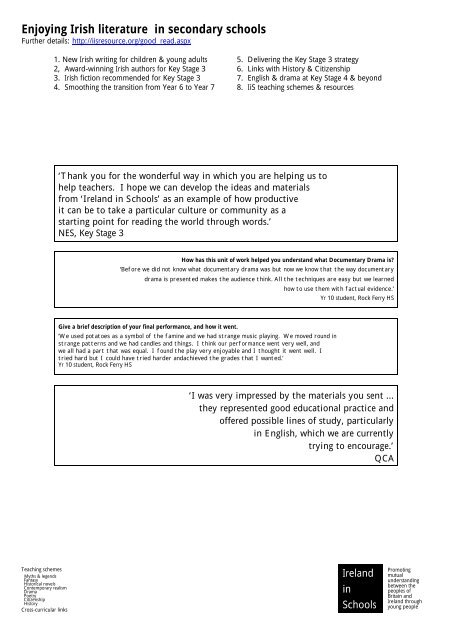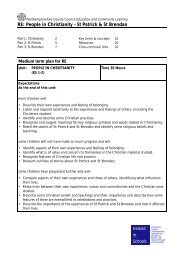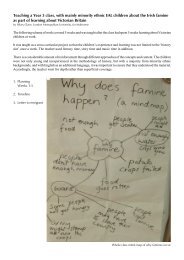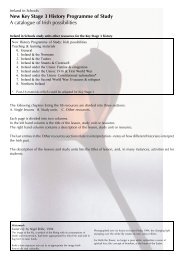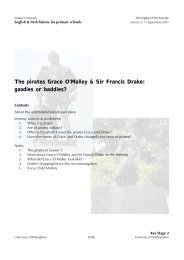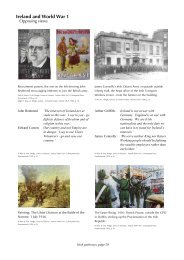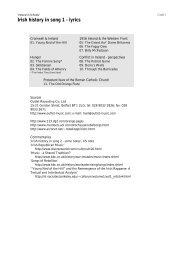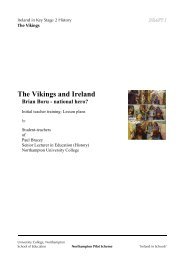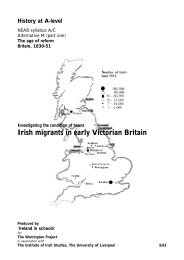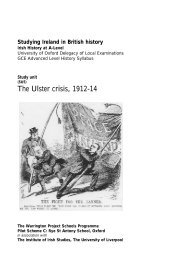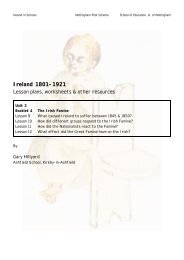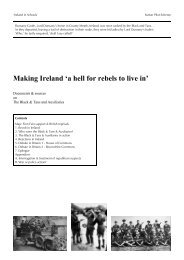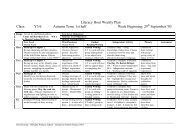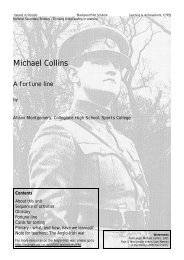Enjoying Irish literature in secondary schools - Ireland in Schools
Enjoying Irish literature in secondary schools - Ireland in Schools
Enjoying Irish literature in secondary schools - Ireland in Schools
You also want an ePaper? Increase the reach of your titles
YUMPU automatically turns print PDFs into web optimized ePapers that Google loves.
<strong>Enjoy<strong>in</strong>g</strong> <strong>Irish</strong> <strong>literature</strong> <strong>in</strong> <strong>secondary</strong> <strong>schools</strong>Further details: http://iisresource.org/good_read.aspx1. New <strong>Irish</strong> writ<strong>in</strong>g for children & young adults 5. Deliver<strong>in</strong>g the Key Stage 3 strategy2, Award-w<strong>in</strong>n<strong>in</strong>g <strong>Irish</strong> authors for Key Stage 3 6. L<strong>in</strong>ks with History & Citizenship3. <strong>Irish</strong> fiction recommended for Key Stage 3 7. English & drama at Key Stage 4 & beyond4. Smooth<strong>in</strong>g the transition from Year 6 to Year 7 8. IiS teach<strong>in</strong>g schemes & resources‘Thank you for the wonderful way <strong>in</strong> which you are help<strong>in</strong>g us tohelp teachers. I hope we can develop the ideas and materialsfrom ‘<strong>Ireland</strong> <strong>in</strong> <strong>Schools</strong>’ as an example of how productiveit can be to take a particular culture or community as astart<strong>in</strong>g po<strong>in</strong>t for read<strong>in</strong>g the world through words.’NES, Key Stage 3How has this unit of work helped you understand what Documentary Drama is?‘Before we did not know what documentary drama was but now we know that the way documentarydrama is presented makes the audience th<strong>in</strong>k. All the techniques are easy but we learnedhow to use them with factual evidence.’Yr 10 student, Rock Ferry HSGive a brief description of your f<strong>in</strong>al performance, and how it went.‘We used potatoes as a symbol of the fam<strong>in</strong>e and we had strange music play<strong>in</strong>g. We moved round <strong>in</strong>strange patterns and we had candles and th<strong>in</strong>gs. I th<strong>in</strong>k our performance went very well, andwe all had a part that was equal. I found the play very enjoyable and I thought it went well. Itried hard but I could have tried harder andachieved the grades that I wanted.’Yr 10 student, Rock Ferry HS‘I was very impressed by the materials you sent ...they represented good educational practice andoffered possible l<strong>in</strong>es of study, particularly<strong>in</strong> English, which we are currentlytry<strong>in</strong>g to encourage.’QCATeach<strong>in</strong>g schemesMyths & legendsFantasyHistorical novelsContemporary realismDramaPoetryCitizenshipHistoryCross-curricular l<strong>in</strong>ks<strong>Ireland</strong><strong>in</strong><strong>Schools</strong>Promot<strong>in</strong>gmutualunderstand<strong>in</strong>gbetween thepeoples ofBrita<strong>in</strong> and<strong>Ireland</strong> throughyoung people
1. New <strong>Irish</strong> writ<strong>in</strong>g for children & young adults<strong>Irish</strong> drama and poetry have long graced the curriculum <strong>in</strong> <strong>schools</strong> <strong>in</strong> Brita<strong>in</strong>, particularly at GCSE and A-level,and cont<strong>in</strong>ue to do so. Now, however, new <strong>Irish</strong> writers are produc<strong>in</strong>g a wide range of fiction for children andyoung adults.Deliver<strong>in</strong>g - & enrich<strong>in</strong>g - National StrategiesIn pilot schemes run by ‘<strong>Ireland</strong> <strong>in</strong> <strong>Schools</strong>’ (IiS), <strong>Irish</strong> texts are help<strong>in</strong>g teachers to meet and go beyond therequirements of government strategies. They enriched the National Literacy Strategy at Key Stages 1 & 2 andare now do<strong>in</strong>g the same for <strong>secondary</strong> English.Teach<strong>in</strong>g schemesTeach<strong>in</strong>g schemes on <strong>Irish</strong> texts are <strong>in</strong>cluded on the IiS CD-ROM E01 along with other resources for English,Drama and Literacy for Key Stage 3 to A-level. All schemes have been developed by practis<strong>in</strong>g teachers andproved <strong>in</strong> the classroom.Broad appealThe success of these schemes lies <strong>in</strong> the excellence of the teach<strong>in</strong>g and <strong>in</strong> the range and quality of <strong>Irish</strong>children’s <strong>literature</strong> - myths & legends, historical novels, fantasy and contemporary realism. There are booksand stories to suit all ages and abilities, allow<strong>in</strong>g all to participate <strong>in</strong> a common project. All can enjoy read<strong>in</strong>gbooks which are suited to their <strong>in</strong>dividual <strong>in</strong>terests and abilities.Fantasy - for boysPilot <strong>schools</strong> have had their share of reluctant readers among the boys, but they all respond to tales of fantasyby <strong>Irish</strong> authors, such as Eo<strong>in</strong> Colfer’s Artemis Fowl.Myths & legendsThe comb<strong>in</strong>ation of the heroic and the magical, and the feist<strong>in</strong>ess of <strong>Irish</strong> hero<strong>in</strong>es, appealsacross gender and age and ability ranges. Among the illustrated collections, the favouriteis Sionbhe Lally’s lavish Favourite <strong>Irish</strong> Fairy Tales.Liam Mac Uist<strong>in</strong>’s Celtic Magic Tales shows magical powers gett<strong>in</strong>g people <strong>in</strong>to and out oftrouble (‘Quest for Aideen’); heroes, like Cuchula<strong>in</strong>n, <strong>in</strong>volved <strong>in</strong> deadly or humourouscontests; and love br<strong>in</strong>g<strong>in</strong>g tragedy - ‘Deirdre & the Sons of Usnach’, an epic story ofbravery, loyalty and honour m<strong>in</strong>gled with jealousy, betrayal and death - an early exampleof tragic love <strong>in</strong> European <strong>literature</strong>.Historical novels<strong>Ireland</strong>’s history - generally flashpo<strong>in</strong>t periods when conflict<strong>in</strong>g ideologies meet and when conflict<strong>in</strong>g loyaltiesare tested - rema<strong>in</strong>s a focus of <strong>Irish</strong> writ<strong>in</strong>g for the young. Very popular is Under the Hawthorn Tree by MaritaConlon-McKenna, the first of an award-w<strong>in</strong>n<strong>in</strong>g trilogy. It is a gripp<strong>in</strong>g story of love, loyalty and courage set<strong>in</strong> the devastation of the <strong>Irish</strong> Fam<strong>in</strong>e of the 1840s, when three children were left to fend for themselves. AChannel 4 film of the book helps to ease the way for reluctant or slower readers.Contemporary realismMore writers are now portray<strong>in</strong>g a vision of the country <strong>in</strong> which their young readers arethemselves grow<strong>in</strong>g up, free from the ‘Oirish’ stereotyp<strong>in</strong>g.Some of this rema<strong>in</strong>s ‘middle-class <strong>literature</strong>’, featur<strong>in</strong>g at least one work<strong>in</strong>g parent, withaspirations to education and a positive social ideology for teenagers to rebel aga<strong>in</strong>st. 1 Othernovels, though, address less comfortable aspects, ‘the grow<strong>in</strong>g underbelly’, of modern <strong>Irish</strong>society. 21 Such as Marilyn Taylor’s ‘Jackie trilogy’, Jane Mitchell’s When Stars Stop Sp<strong>in</strong>n<strong>in</strong>g and Eo<strong>in</strong> Colfer’s Benny and Omar and Benny and Babe.2 Such as ‘the new not-work<strong>in</strong>g class’ (Siobhán Park<strong>in</strong>son’s Break<strong>in</strong>g the Wishbone), foster families (Park<strong>in</strong>son’s The Moon K<strong>in</strong>g (E31), dysfunctional families (Marita ConlonMcKenna, No Goodbye), prejudice aga<strong>in</strong>st gypsies (Conlon McKenna, The Blue Horse) and political violence (Mark O’Sullivan, Silent Stones).IiS, Enrich<strong>in</strong>g English <strong>in</strong> <strong>secondary</strong> <strong>schools</strong>, 2
Poetry<strong>Irish</strong> poets are studied at Key Stages 3 & 4 and have provided the coursework element of two English schemesfor GCSE. Students’ assignments show how much the schemes of work fostered an appreciation andenjoyment of poetry and knowledge and understand<strong>in</strong>g of <strong>Ireland</strong>. Particularly gratify<strong>in</strong>g is the work ofstudents who usually write half a page but become expansive when respond<strong>in</strong>g to contemporary <strong>Irish</strong> poems.Drama<strong>Irish</strong> materials are a powerful stimulus to orig<strong>in</strong>al drama. At Key Stage 3 and GCSE, the Fam<strong>in</strong>e promptsthoughtful and imag<strong>in</strong>ative work, but at A-level, one teacher uses a wide range of <strong>Irish</strong> writ<strong>in</strong>g to provide the‘spark for drama. Their quality is typical of a culture which has produced many of the greatest writers <strong>in</strong> the Englishlanguage and concern the basic questions of human existence which dom<strong>in</strong>ate our lives whatever our country of birth’.L<strong>in</strong>ks with Citizenship & HistoryThe <strong>in</strong>ter-tw<strong>in</strong><strong>in</strong>g of <strong>Irish</strong> <strong>literature</strong> and history and the complex issues raised provide opportunities forEnglish and History teachers to improve the learn<strong>in</strong>g experience of students and to make more effective useof scarce resources.The poetry of ‘the troubles’ dramatically deepens students’ understand<strong>in</strong>g of what it is like to live <strong>in</strong> such adivided society as Northern <strong>Ireland</strong>, while orig<strong>in</strong>al drama <strong>in</strong>spired by the <strong>Irish</strong> Fam<strong>in</strong>e helps to deliver the‘essential elements of citizenship’.Two historical novels (The Guns of Easter by Gerard Whelan and No Peace for Amelia bySiobhán Park<strong>in</strong>son) underp<strong>in</strong> a Year 9 scheme which develops th<strong>in</strong>k<strong>in</strong>g, literacy andcitizenship skills - see page 8 below.The novels tell the experience of 1916 - why some <strong>Irish</strong>men jo<strong>in</strong>ed the British army to fightaga<strong>in</strong>st Germany, while others fought aga<strong>in</strong>st the British and appealed for German aid dur<strong>in</strong>gthe Easter Ris<strong>in</strong>g - through the eyes of two young Dubl<strong>in</strong> people from very differentbackgrounds, one a Catholic boy, the other a Quaker girl. They ‘vividly rem<strong>in</strong>d readers of thehuman and social dimensions to the school subject usually referred to <strong>in</strong> mere abstract terms as “history”’.The O’Brien Press, <strong>Ireland</strong>’s lead<strong>in</strong>g publisher of books for children, has published a series of guides tohelp <strong>Irish</strong> teachers use the Press’s authors <strong>in</strong> the classroom.The suggestions for teach<strong>in</strong>g can readily be adapted to the curriculum <strong>in</strong> England, Wales and Scotland.Real Books offers general suggestions for most of the texts. The other Guides provide more detailedguidance for a selection of the Press’s fiction for children and young adults.Real Books for Primary <strong>Schools</strong>, 0-86278-609-6Teach<strong>in</strong>g GuidesCollection 1, 0-86278-633-0Collection 2, 0-86278-666-5Collection 3, 0-86278-697-5Second -Level <strong>Schools</strong> Book 1, 0-86278-682-7http://www.obrien.ie/<strong>schools</strong>IiS, Enrich<strong>in</strong>g English <strong>in</strong> <strong>secondary</strong> <strong>schools</strong>, 3
2. Award-w<strong>in</strong>n<strong>in</strong>g <strong>Irish</strong> authors for Key Stage 3White Lies by O’Sullivan, Mark, Wolfhound Press, 0-86327-592-3This rollercoaster of the stormy relationship between two seventeen-year-olds is told by eachcharacter <strong>in</strong> turnabout chapters by Nance, black and adopted, and OD, a school drop-out withattitude.Nance journeys <strong>in</strong>to the past to discover her roots and identity only to f<strong>in</strong>d the truth is nearerhome. OD dropped out of school at sixteen, works on a job creation scheme on a build<strong>in</strong>g siteand has an attitude. Unable to get on with his washed-up, alcoholic trumpet-play<strong>in</strong>g father,he becomes embroiled <strong>in</strong> shady deal<strong>in</strong>gs, his best friend Beano gets <strong>in</strong>to drugs, and he falls outwith Nance.Liv<strong>in</strong>g their lives on the edge of adulthood, they have to face up to choices and the truth beh<strong>in</strong>d white lies.Mark O’Sullivan is, perhaps, the most gifted of writers for young people <strong>in</strong> <strong>Ireland</strong>.NanceI suppose you could call it delayed shock. It had beentwo weeks s<strong>in</strong>ce I’d found the photo, and my life had goneon as normal. At least, that’s how it must have seemed toOD, my boyfriend, and to everyone else. But <strong>in</strong>side I’dgone numb. I couldn’t th<strong>in</strong>k, I couldn’t study. I felt noth<strong>in</strong>g.And then I cracked.The child <strong>in</strong> the photo was me. I was certa<strong>in</strong> of it. Mybrown sk<strong>in</strong>, the tight black curls, someth<strong>in</strong>g about the eyes.I don’t know how long I spent there, gap<strong>in</strong>g at the photo,before I put it back exactly where I found it; but, to thisday, I can remember every detail of it. The impossibly bluesky, the lush green trees <strong>in</strong> the background, the brightcolours of their clothes. There were five adults <strong>in</strong> thephoto.... The strange th<strong>in</strong>g ... was that not one of themwere smil<strong>in</strong>g except the woman who held me. Thisconv<strong>in</strong>ced me even more she really was my natural mother.ODWhen you th<strong>in</strong>k th<strong>in</strong>gs can’t get any worse, that’s when you can be sure theywill. Call it OD’s Law if you like - Disaster plus X (the unknown, the future, thenext m<strong>in</strong>ute) equals Double Disaster. That afternoon, as I left Jimmy <strong>in</strong> hisfantasy world where money didn’t matter, I was lower than zero. Then I shotdown the m<strong>in</strong>us scale.I was at the gate before I copped Seanie’s puke-green Popemobile parked nearBeano’s house. I couldn’t make sense of the scene. It was like see<strong>in</strong>g a hearseoutside a disco or someth<strong>in</strong>g off-the-wall like that. Seanie wasn’t look<strong>in</strong>g <strong>in</strong> mydirection but star<strong>in</strong>g worriedly at the passenger seat. Next th<strong>in</strong>g I saw Nance’shead appear. I didn’t wait to see her face. I staggered back towards the houselike I was go<strong>in</strong>g home after a night at the Galtee Lounge. I went out the backway by the lane beh<strong>in</strong>d our house.My heart was bang<strong>in</strong>g out a mad beat somewhere between reggae, rap andhouse. The lyrics went someth<strong>in</strong>g like ‘It doesn’t matter’, or ‘So what’, but theydidn’t fit the rhythm. At the same time, someone must have been stick<strong>in</strong>g p<strong>in</strong>s<strong>in</strong>to a little effigy of me because my knee was peppered with st<strong>in</strong>g<strong>in</strong>g jabs.Also by Mark O’SullivanSilent Stones, Wolfhound Press, 0-86327-722-5A gripp<strong>in</strong>g, thought-provok<strong>in</strong>g and mov<strong>in</strong>g story of two teenagers forced to come to terms with their families’ pastsat Cloghercree <strong>in</strong> the <strong>Irish</strong> Midlands. Mayfly Blenthyne is there because her English New-Age traveller parentsbelieve that the ancient stand<strong>in</strong>g stones will miraculously cure her dy<strong>in</strong>g mother. Robby Wade is there because,trapped between his embittered great-uncle and the shadow of his dead IRA father, he cannot escape. Matters cometo a head when Cloghercree is <strong>in</strong>vaded by the ruthless terrorist, Razor McCabe, on the run from the police.Sisters ... no way! by Park<strong>in</strong>son, Siobhán, O’Brien Press, 0-86278-495-6A flipper - and brilliant - book, it deals with teenage life <strong>in</strong> an amus<strong>in</strong>g and unusual way, us<strong>in</strong>g a dual diaryformat and two very different characters to expose very sensitive and personal problems common to youngpeople, problems largely caused by adults.C<strong>in</strong>dy does not want her dad to remarry after her mother’s death - especially not the divorced mum of theprissy and utterly bor<strong>in</strong>g Ashl<strong>in</strong>g. Ashl<strong>in</strong>g, <strong>in</strong> turn, wants her mother to f<strong>in</strong>d a nice man, but does it have tobe the widowed father of the noxious C<strong>in</strong>dy, arch-snob and ultra-op<strong>in</strong>ionated? No way do these two wantto become sisters and make their feel<strong>in</strong>gs clear <strong>in</strong> their diaries.IiS, Enrich<strong>in</strong>g English <strong>in</strong> <strong>secondary</strong> <strong>schools</strong>, 4
Ashl<strong>in</strong>g, Wednesday, 21 & 28 MayIt happened aga<strong>in</strong> this even<strong>in</strong>g. Mum was on thephone dur<strong>in</strong>g my practis<strong>in</strong>g time. This time theother person rang her, though, so it’s not her fault.I’m dy<strong>in</strong>g to know if it’s the tall dark stranger. Ihope so. Wouldn’t it be great if Mum had a - Idon’t know how to put this - ‘boyfriend’ soundstoo girlish, ‘man’ sounds too racy, ‘partner’ soundstoo proprietorial, ‘friend’ sounds too coy. Butmaybe it was just somebody she got talk<strong>in</strong>g to outside the gallery.Maybe she was just tell<strong>in</strong>g him where the cloakroom was. Maybe theywere just two people exchang<strong>in</strong>g remarks on the street. But who isr<strong>in</strong>g<strong>in</strong>g her up? I just hope he’s not married, that’s all. Mum wouldn’tdream of it if he is of course. I mean, I hope he’s not married andpretend<strong>in</strong>g not to be....Well! a great leap forward! Mum’s go<strong>in</strong>g out tonight with Richard.Richard is her new gentleman caller. That’s what she called himwhen she told us about him. It’s a little joke, that, a reference to aplay, I th<strong>in</strong>k. I don’t know much about plays. Maths and science aremore my l<strong>in</strong>e than EnglishShe told us this morn<strong>in</strong>g at breakfast. I don’t th<strong>in</strong>k she chosebreakfast on purpose because it’s a rushed meal and we have to leavefirst to catch the bus. I th<strong>in</strong>k she must have been work<strong>in</strong>g up to it forsometime.C<strong>in</strong>dy, Friday, 23 MayIt makes you wonder. I mean, Mum is not even two months dead,and there he is throw<strong>in</strong>g himself at another woman. How could hebe so callous? He can’t have loved her at all. Or maybe he did just atthe beg<strong>in</strong>n<strong>in</strong>g. I mean, there’s me, after all, so there must have beensometh<strong>in</strong>g there at one time. I was born six months after they weremarried. Mum used to joke about it, say I was a miracle baby. WhenI was small, I used to believe it, that I was really amaz<strong>in</strong>gly premature,but when I got older, I realised she was only jok<strong>in</strong>g, that she waspregnant when she got married. I used to be proud of that. I felt itproved my parents were unconventional and passionate. Now itmakes me wonder. Maybe she pressurised him <strong>in</strong>to marry<strong>in</strong>g her.Maybe she even got pregnant on purpose so he’d have to marry her.Maybe she only wanted an <strong>Irish</strong> passport. (I haven’t worked out why,though, that’s still a bit obscure.)I often wondered why I was an only child. I assumed it wassometh<strong>in</strong>g gynaecological. Mum used to have a terrible time with herperiods, and when I was about ten she f<strong>in</strong>ally had a hysterectomy, soI thought that was it. But now I wonder. Maybe they had given upsleep<strong>in</strong>g together. I mean, they always had a double bed, but youknow what I mean, though now I come to th<strong>in</strong>k of it, Dad used tospend a lot of time <strong>in</strong> the spare room, even before she got sick.Maybe he’s been a philanderer all along. The pig.Also by Siobhán Park<strong>in</strong>sonBreak<strong>in</strong>g the Wishbone, O’Brien Press, 0-86278-635-5This <strong>in</strong>ventive exploration of how five homeless teenagers <strong>in</strong> a Dubl<strong>in</strong> squat face the most harrow<strong>in</strong>g situations withhumour, courage and resilience takes the form of a ‘documentary, if you like, heads to camera, as they piece theirstories together’. For Johnner it’s a bit like camp<strong>in</strong>g - for a while. Beano is manipulative, violent and controll<strong>in</strong>g,out to score whatever and whenever he can. Carol<strong>in</strong>e, overwhelmed by loss, is distant and confused. Samanthaconjures up dreams to keep herself go<strong>in</strong>g. Curly is somewhat slow but honest and steady, try<strong>in</strong>g hard to make thebest of a bad lot.The Guns of Easter by Whelan, Gerard, O’Brien Press, 0-86278-449-2It is 1916 and Jimmy Conway, aged 12, from the Dubl<strong>in</strong> slums, is caught up <strong>in</strong> the Easter Ris<strong>in</strong>g and f<strong>in</strong>dshis loyalties sorely tested.While his father is away <strong>in</strong> France, fight<strong>in</strong>g with the British army, his uncle Mick jo<strong>in</strong>s theRis<strong>in</strong>g, fight<strong>in</strong>g aga<strong>in</strong>st the British army <strong>in</strong> Dubl<strong>in</strong>, Jimmy feels he must be the provider forhis mother and two younger sisters.With the GPO <strong>in</strong> the hands of the Volunteers his family is deprived of the all-importantSeparation Allowance. Sett<strong>in</strong>g out to f<strong>in</strong>d food or money, Jimmy f<strong>in</strong>ds himself adrift <strong>in</strong> anightmare version of the world he has known and must come to terms with a great deal beforehe returns home. On one level The Guns of Easter is a story of war, on another it is the tale ofa young boy's brutal forced awaken<strong>in</strong>g to the complexities of the world and adult life.Jimmy wished more than ever that Da could be here now. The fact thathe wasn’t made Jimmy the man of the house, and at twelve years of ageJimmy found that hard. The man of the house was supposed to know rightfrom wrong, but Jimmy didn’t always f<strong>in</strong>d this so simple. And then aga<strong>in</strong>even adults couldn’t seem to agree on what was right and what wasn’t.Uncle Mick, for <strong>in</strong>stance, had been furious with Da for jo<strong>in</strong><strong>in</strong>g the army.‘How can he fight for the British?’ Mick asked Ma when he heard thenews. ‘And for what? For their money.’This was just after Da went away. A week before, Ma herself had beengiv<strong>in</strong>g out to Da for sign<strong>in</strong>g up, but now she turned on Mick.‘There’s food for the children now,’ she said. ‘That’s what thatmoney means to James. That’s all that war means to him. He wasnever out play<strong>in</strong>g soldiers like you and your Citizen Armyfriends.’Mick looked <strong>in</strong>sulted but Ma cont<strong>in</strong>ued, anger <strong>in</strong> her voicenow. ‘It’s all very well for you, Mick. You’re s<strong>in</strong>gle, and you haveno-one to look after, barr<strong>in</strong>g yourself. You can afford dreams andhigh ideas. How long would your dreams last if they were all youhad to br<strong>in</strong>g home to a house full of hungry children? Dreamsmake bad d<strong>in</strong>ners, Mick.’Also by Gerard WhelanDream Invader, O’Brien Press, 0-86278-516-2This is one of the scariest tales of ‘good versus evil’ ever written for children. The prize at stake is a little boy’s life.Every night Saskia’s cous<strong>in</strong>, Simon, wakes scream<strong>in</strong>g and terrified <strong>in</strong> his new car-shaped bed, for the most horrificjourneys are be<strong>in</strong>g undertaken <strong>in</strong> a green car by Simon and his tormentor, the Pooshipaw. The Pooshipaworchestrates Simon’s dreams. The further down the road they travelled, the more sick and frighten<strong>in</strong>g were thescenes at the roadside. With every dream Simon grew more afraid because at the end, the Pooshipaw warns Simon,‘dreams of you will be all your precious Mammy and Daddy have left’. Pooshipaw was not a nice man at all ....IiS, Enrich<strong>in</strong>g English <strong>in</strong> <strong>secondary</strong> <strong>schools</strong>, 5
4. Smooth<strong>in</strong>g the transition from Year 6 to Year 7Nott<strong>in</strong>gham County Council and ’<strong>Ireland</strong> <strong>in</strong> <strong>Schools</strong>’ co-operated to show how <strong>Irish</strong> texts, fantasy and mythsand legends, could prepare Year 6 children for <strong>secondary</strong> <strong>schools</strong> and give their new Year 7 tutors a betterappreciation of their abilities.The texts - good versus evilThe Battle below Giltspur by Cormac MacRaois, Wolfhound Press, 086327 356 4The Year 6 scheme is based on one text - The Battle below Giltspur. Set <strong>in</strong> modern County Wicklow, <strong>Ireland</strong>,it provides opportunities to work on the themes of mystery and fantasy, with real characters embark<strong>in</strong>g upona journey and mythical characters and powers appear<strong>in</strong>g with<strong>in</strong> a modern sett<strong>in</strong>g.When the ancient force of Bealta<strong>in</strong>e blows on May Day, and fuses life <strong>in</strong>to the scarecrow near Niamh andDaire Durkan’s home, Glasán isn’t the only scarecrow to visit them. The Black One has also been awakenedby the power of the Bealta<strong>in</strong>e w<strong>in</strong>ds. Niamh and Daire f<strong>in</strong>d themselves drawn <strong>in</strong>to a dangerous attempt todestroy the evil powers of Greyfang and Deathtooth as the open<strong>in</strong>g foreshadows:THE ROOKS OF GILTSPUR WOOD were all of a flutter. They could not roost easily <strong>in</strong> their tall weather-beaten p<strong>in</strong>es. They kept shuffl<strong>in</strong>g about on theirhorny claws, caw<strong>in</strong>g and mutter<strong>in</strong>g to each other. Then they would suddenly leap <strong>in</strong>to the air a frantic flapp<strong>in</strong>g of their ragged black w<strong>in</strong>gs and just as quicklyturn and land aga<strong>in</strong>.Scrags was angry. Scrags, the biggest, fiercest old rook was K<strong>in</strong>g of the Wood. For more years than any of them could count he had ruled his k<strong>in</strong>gdom highon the south slope of Little Sugarloaf Mounta<strong>in</strong> <strong>in</strong> County Wicklow. When Scrags was angry everyone was nervous.Fast, tense and full of blood-curdl<strong>in</strong>g happen<strong>in</strong>gs, The Battle below Gilstpur is a rivett<strong>in</strong>g fantasy, a magical taleof power and revenge, blend<strong>in</strong>g high adventure and ancient <strong>Irish</strong> myth. MacRaois triumphantly avoids thepietism of many ‘good-versus-evil’ books by creat<strong>in</strong>g characters, real and supernatural, who move beyond mereallegory <strong>in</strong>to forceful credibility, as myth crosses over to children’s lives with most powerful results.Celtic Magic Tales by Liam Mac Uist<strong>in</strong>, O’Brien Press, 0-86278-341-0The Year 7 scheme is based on two texts Celtic Magic Tales by Liam Mac Uist<strong>in</strong> and The Old Stories by Kev<strong>in</strong>Crossley-Holland. Whereas the latter is well-known to teachers <strong>in</strong> English <strong>schools</strong> and needs no explanation,Celtic Magic Tales is not so widely known and used, despite be<strong>in</strong>g praised as ‘a collection to stir any heart’ and‘magical stuff and a perfect gift’.Of all the Celtic countries <strong>Ireland</strong> has preserved the richest store of stories from its Celtic past which was rich<strong>in</strong> mythology and belief <strong>in</strong> magic and the supernatural. In <strong>Ireland</strong> these stories were passed on <strong>in</strong> Gaelic fromone generation to another and, later, with the com<strong>in</strong>g of Christianity they were written down by monasticscribes.In that other world magic can be used for good or evil. Magical powers are used to get people <strong>in</strong>to and outof trouble, as <strong>in</strong> ‘The quest for Aideen’. In other stories, <strong>in</strong>volv<strong>in</strong>g Cuchula<strong>in</strong>n, heroes are at each other’sthroats or <strong>in</strong>volved <strong>in</strong> humorous contests. F<strong>in</strong>ally, the notion of love that br<strong>in</strong>gs tragedy to the lovers is oneof the grander themes of traditional Gaelic storytell<strong>in</strong>g, as <strong>in</strong> ‘Deirdre and the sons of Usnach’. One of theearliest examples of tragic love <strong>in</strong> European <strong>literature</strong>, it is ‘an epic story of bravery, loyalty and honour<strong>in</strong>term<strong>in</strong>gled with jealousy, betrayal and death.’BenefitsThe bridg<strong>in</strong>g unit helped to• safeguard and build on the ga<strong>in</strong>s made at Key Stage 2 through the National Literacy Strategy;• improve cont<strong>in</strong>uity of teach<strong>in</strong>g and learn<strong>in</strong>g from Year 6 to Year 7;• provide early, tailored <strong>in</strong>tervention to secure Level 4 for pupils still at Level 3, and those below;• establish systematic and co-ord<strong>in</strong>ated support for literacy across the curriculum;• raise the threshold for entry at Key Stage 4 and subsequent results; and• improve motivation for both teachers and pupils at Key Stage 3.IiS, Enrich<strong>in</strong>g English <strong>in</strong> <strong>secondary</strong> <strong>schools</strong>, 7
5. Deliver<strong>in</strong>g the Key Stage 3 strategyTo assist the <strong>in</strong>troduction of the Key Stage 3 English strategy, ‘<strong>Ireland</strong> <strong>in</strong> <strong>Schools</strong>’ worked with Sue Hackman,then National Director for Key Stage 3 English, to provide exemplar material based on a contemporary <strong>Irish</strong>text. Lead<strong>in</strong>g literacy experts and experienced teachers devised detailed schemes of work for Year 7 and Year8, each consist<strong>in</strong>g of a text unit and a research unit.The text: Four Kids, Three Cats, Two Cows, One Witch (maybe) by Siobhán Park<strong>in</strong>son, O’Brien Press, 0-86278-515-4Four kids and a cat visit the mysterious, un<strong>in</strong>habited Lady Island, <strong>in</strong> Famous Five style, complete with food,matches and First Aid kit. They are expect<strong>in</strong>g some danger, but noth<strong>in</strong>g prepares them for their encounter withthe strange <strong>in</strong>habitant of the island. The structure and style of the book are not unusual, tak<strong>in</strong>g the theme ofa journey and each youngster tells a short, symbolic, story, reveal<strong>in</strong>g much about their lives, <strong>in</strong> the manner ofChaucer. What is unusual about the book is that the characters change after their story tell<strong>in</strong>g dur<strong>in</strong>g what maybe considered a fairly simple and safe out<strong>in</strong>g. The children emerge more mature with their own personal foiblescontrolled.The text unitsThe text units concentrate on the text and consist of fifteen lessons. Lessons 1-6 study the author’s developmentof sett<strong>in</strong>g, themes and characterisation; lessons 7-13 study the literary technique of develop<strong>in</strong>g an oral tale with<strong>in</strong> anarrative <strong>in</strong> order to develop characterisation and the wider themes of the novel; and lessons 14-15 encourage speak<strong>in</strong>gand writ<strong>in</strong>g critically about the novel and express<strong>in</strong>g an op<strong>in</strong>ion, orally and <strong>in</strong> writ<strong>in</strong>g, on the book’s relevance andappropriateness to a contemporary teenage audience.The research unitsEach research unit consists of n<strong>in</strong>e lessons, develop<strong>in</strong>g research skills on authors and <strong>Ireland</strong>, with an emphasison ICT. Part one, author research, consists of four lessons for Year 7 and five lessons for Year 8: research<strong>in</strong>g anauthor, research<strong>in</strong>g other authors <strong>in</strong>dependently and present<strong>in</strong>g f<strong>in</strong>d<strong>in</strong>gs about the authors. Part two, <strong>Ireland</strong> research,comprises five lessons for Year 7 and four lessons for Year 8: research<strong>in</strong>g the cultural background of texts, research<strong>in</strong>gan aspect of <strong>Irish</strong> culture and presentation (oral or written) of f<strong>in</strong>d<strong>in</strong>gs, particularly by writ<strong>in</strong>g web site material.Meet<strong>in</strong>g Key Stage 3 English objectivesYear 7Text unitResearch unitYear 8Text unitResearch unitWord levelSentence levelRead<strong>in</strong>gWrit<strong>in</strong>gSpeak<strong>in</strong>g & listen<strong>in</strong>g3, 4, 141, 3, 86, 7, 12, 14, 151, 2, 6, 8, 192, 101, 3, 13a1, 2, 3, 4, 5, 102, 113, 5, 6, 8, 11, 121c, 1d, 7a, 7c, 111, 2, 3, 74, 5, 6, 101, 3, 6, 7, 17, 181, 2, 9111, 91, 2, 3, 5, 6, 91, 101, 7, 11, 12The authorSiobhán Park<strong>in</strong>son lives <strong>in</strong> Dubl<strong>in</strong> with her woodturner husband Roger Bennett and their son Matthew, her personal 15 yearold proofreader. She also has connections with Loughrea, Co. Galway, and Letterkenny, Co. Donegal, where she was educated.Siobhán studied English <strong>literature</strong> and worked as an editor <strong>in</strong> the publish<strong>in</strong>g and computer <strong>in</strong>dustries, and with a nationalresearch and development agency on hous<strong>in</strong>g and homelessness. She has recently completed a year as Writer <strong>in</strong> Residence <strong>in</strong> the<strong>Irish</strong> Writers’ Centre, and is Writer <strong>in</strong> Residence <strong>in</strong> the Church of <strong>Ireland</strong> College of Education. Her primary <strong>in</strong>terests areread<strong>in</strong>g and writ<strong>in</strong>g. She also s<strong>in</strong>gs <strong>in</strong> a choir (but quietly, <strong>in</strong> case she is found out!).Her first three books about town and country and a leprechaun were aimed at the 6-9 age group. With her fourth and fifth booksAmelia and its sequel, No Peace for Amelia, Siobhán wrote for the older age group, 10 plus, relat<strong>in</strong>g the grow<strong>in</strong>g pa<strong>in</strong>s of a naiveQuaker teenager <strong>in</strong> Dubl<strong>in</strong>, faced first with family ru<strong>in</strong> and the big questions raised by the First World War andthe 1916 Easter Ris<strong>in</strong>g. Sisters ... No Way! (1996) is a modern story of very reluctant step-sisters, written for theyoung teen market. A bestseller, it has been translated <strong>in</strong>to French and Italian and was the overall w<strong>in</strong>ner of theBisto Book of the Year Award <strong>in</strong> 1997, be<strong>in</strong>g praised as ‘<strong>Irish</strong> teenage fiction at its most sophisticated’. FourKids, Three Cats, Two Cows, One Witch ...Maybe (1997) won a Bisto Book of the Year Merit Award and waspraised as ‘one of the best <strong>Irish</strong> children’s books we’ve ever had’ by <strong>Ireland</strong>’s lead<strong>in</strong>g authority on children’s<strong>literature</strong>.IiS, Enrich<strong>in</strong>g English <strong>in</strong> <strong>secondary</strong> <strong>schools</strong>, 8
6. L<strong>in</strong>ks with History & citizenship 1916: Fight<strong>in</strong>g for whom?Why <strong>in</strong> 1916 did some <strong>Irish</strong>men jo<strong>in</strong> the British army to fight aga<strong>in</strong>st Germany, while others fought aga<strong>in</strong>stthe British and appealed for German aid dur<strong>in</strong>g the Easter Ris<strong>in</strong>g? A widely-acclaimed Year 9 study unit usestwo historical novels to explore the complex web of loyalties that united and divided Brita<strong>in</strong> and <strong>Ireland</strong> <strong>in</strong> theearly twentieth centuries: The Guns of Easter by Gerard Whelan and No Peace for Amelia by Siobhán Park<strong>in</strong>son.The historical novelsThe novels have been chosen not only for their literary merit but also because the experience of 1916 is toldthrough the eyes of two young people from very different backgrounds, Jimmy Conway, aged 12, a Catholicboy, and Amelia Pim, aged 15, a Quaker.Jimmy Conway lives <strong>in</strong> the Dubl<strong>in</strong> slums and is caught up <strong>in</strong> theEaster Ris<strong>in</strong>g. While his father is away <strong>in</strong> France, fight<strong>in</strong>g withthe British army, his uncle Mick jo<strong>in</strong>s the Ris<strong>in</strong>g, fight<strong>in</strong>g aga<strong>in</strong>stthe British army <strong>in</strong> Dubl<strong>in</strong>. Jimmy feels he must be the providerfor his mother and two younger sisters. Sett<strong>in</strong>g out to f<strong>in</strong>d foodor money, he f<strong>in</strong>ds himself adrift <strong>in</strong> a nightmare version of theworld he has known, question<strong>in</strong>g old loyalties.Amelia Pim, on the other hand, lives <strong>in</strong> a Quaker family <strong>in</strong> a welloffdistrict of Dubl<strong>in</strong>. One of her best friends is Mary-AnnMaloney, who works as cook-general. Amelia has a boyfriendcalled Frederick Goodbody, who volunteers to fight <strong>in</strong> WorldWar I. Mary-Ann’s elder brother, Patrick, is a member of the<strong>Irish</strong> Volunteers, an army who fight dur<strong>in</strong>g the Easter Ris<strong>in</strong>g for<strong>in</strong>dependence from Brita<strong>in</strong>.The study unitA student workbook, with support<strong>in</strong>g teachers’ notes, tries to adopt an <strong>in</strong>tegrated approach to the participationof <strong>Irish</strong> people <strong>in</strong> two very dramatic events <strong>in</strong> 1916 - the Easter Ris<strong>in</strong>g and fight<strong>in</strong>g on the Western Front. Todeliver the curriculum <strong>in</strong> history and citizenship and to develop literacy and th<strong>in</strong>k<strong>in</strong>g skills, it draws not onlyon the two historical novels but also on recent historical writ<strong>in</strong>gs about the World War I years <strong>in</strong> <strong>Ireland</strong>.Key questionThe key 1916: Fight<strong>in</strong>g for whom? considers why <strong>in</strong> 1916:a. did some <strong>Irish</strong> men and women fight aga<strong>in</strong>st the British army, appeal<strong>in</strong>g for German aid, dur<strong>in</strong>g the Easter Ris<strong>in</strong>g<strong>in</strong> <strong>Ireland</strong>, whileb. other <strong>Irish</strong>men jo<strong>in</strong>ed the British army to fight aga<strong>in</strong>st Germany.Time requiredThe workbook consists of 12 forty-m<strong>in</strong>ute lessons if both the stories (Jimmy’s and Amelia’s) are studied. S<strong>in</strong>cethe stories are very different, the use of both stories will draw out more issues and perspectives. However, iftime is limited, the workbook can be used with only one of the stories. This reduces the number of lessons to9: lessons 1-5 and 9-12 <strong>in</strong> the case of Jimmy’s story; lessons 1-2 and 6-12 <strong>in</strong> the case of Amelia’s story.New perspectives on the <strong>Irish</strong> experience of World War IConventionally, the historiography of early twentieth-century <strong>Ireland</strong> has been dom<strong>in</strong>ated by accounts of oftenviolent conflict between nationalism and unionism; by the clash of soldiers fight<strong>in</strong>g for one side or the other.However, the <strong>Irish</strong> soldiers of World War I and of the immediately follow<strong>in</strong>g years were more thandiametrically opposed contend<strong>in</strong>g groups. While they fought aga<strong>in</strong>st each other <strong>in</strong> 1916 and after, andcerta<strong>in</strong>ly their differences, above all else, were emphasised dur<strong>in</strong>g those years, there were common factors andimpulses which made those <strong>Irish</strong> people act as they did.The National Curriculum - th<strong>in</strong>k<strong>in</strong>g skills & citizenshipThe workbook meets key requirements for History and the new English Strategy at Key Stage 3. At the sametime, because of the diversity of <strong>Irish</strong> responses to events <strong>in</strong> 1916 and starkness of the issues raised, theworkbook also develops th<strong>in</strong>k<strong>in</strong>g skills and addresses issues of citizenship.For the former, it encourages students (a) to form and evaluate their own op<strong>in</strong>ions on the issues raised by warand conflict and the way <strong>in</strong> which such events are remembered and (b) to consider how the skills they havedeveloped may be applied to other circumstances.For citizenship, the workbook gives students the opportunity (a) to understand the diversity of political andreligious beliefs held by people <strong>in</strong> the past; (b) to exam<strong>in</strong>e moral and political dilemmas; and (c) to developmoral and political judgements of their own.IiS, Enrich<strong>in</strong>g English <strong>in</strong> <strong>secondary</strong> <strong>schools</strong>, 9
7. English & drama at Key Stage 4 & beyond‘The troubles’ and contemporary <strong>Irish</strong> poetry English & history at GCSE & Key Stage 3Five poems deal<strong>in</strong>g with ‘the troubles’ have been selected to• help students develop an imag<strong>in</strong>ative <strong>in</strong>sight <strong>in</strong>to recent events <strong>in</strong> Northern <strong>Ireland</strong>; and• suggest a way of us<strong>in</strong>g scarce resources and time <strong>in</strong> <strong>schools</strong> by encourag<strong>in</strong>g English and History teachers to worktogether <strong>in</strong> teach<strong>in</strong>g key areas of the curriculum.The unit consists of a brief <strong>in</strong>troduction, an anthology of five poems of different levels of accessibility by four contemporary<strong>Irish</strong> poets, a series of activities for students, and examples of students’ responses. Both the poems to be studied and theactivities to be undertaken can be varied to suit the time available and the ability of students.As the examples of students’ work show, the poems have been successfully tested with GCSE and Key Stage 3 classes,enhanc<strong>in</strong>g students’ understand<strong>in</strong>g and enjoyment of poetry while at the same time giv<strong>in</strong>g them some <strong>in</strong>sight <strong>in</strong>to thenature of the various conflicts and tensions that go to make up the modern ‘<strong>Irish</strong> question’. Particularly gratify<strong>in</strong>g is thework of students who usually wrote half a page but became expansive when respond<strong>in</strong>g to the poems. 3‘ a British Army Soldierwith a rifle and a radio ...’Enemy Encounter by Padraic FiaccThis poem symbolises all the fight<strong>in</strong>g go<strong>in</strong>g on <strong>in</strong> <strong>Ireland</strong> with all the bomb<strong>in</strong>gs and shoot<strong>in</strong>gs as the separation of <strong>Ireland</strong>cont<strong>in</strong>ues. This division <strong>in</strong> Northern <strong>Ireland</strong> is historical as shown <strong>in</strong> stanza 1 “A wall divides the wet land, planted <strong>in</strong> the past”.Stanza 3 says “A soldier’s gun tra<strong>in</strong>ed on me - teaches noth<strong>in</strong>g new”.’Cross<strong>in</strong>g the <strong>Irish</strong> Sea - literary traditions <strong>in</strong> poetryEnglish & English Literature at GCSE‘Cross<strong>in</strong>g the <strong>Irish</strong> Sea’ is a teach<strong>in</strong>g resource on contemporary <strong>Irish</strong> poetry for the coursework elements of GCSE SEGEnglish 2400P, 2400M and 2400X and English Literature 2495R, 2495T and 2495X.The unit consists of a brief <strong>in</strong>troduction, an anthology of thirty-one poems of different levels of accessibility by a range of<strong>Irish</strong> - and English - poets, an activity booklet for students, and examples of students’ work.The themes addressed <strong>in</strong>clude home & family, local area & community, <strong>Ireland</strong>’s culture, different cultures <strong>in</strong> <strong>Ireland</strong>,history & <strong>Irish</strong> culture, religion & <strong>Irish</strong> culture, language & <strong>Irish</strong> culture, emigration & exile, the uncerta<strong>in</strong>ties of <strong>Irish</strong>poetry, and literary traditions <strong>in</strong> English & <strong>Irish</strong> poetry (the elegy and father & son).Aga<strong>in</strong>, the examples of students’ work underl<strong>in</strong>e the success of the unit <strong>in</strong> promot<strong>in</strong>g both an appreciation and enjoymentof poetry and knowledge and understand<strong>in</strong>g of the rich diversity of the island of <strong>Ireland</strong> and its peoples. 4‘I was a nuisance, tripp<strong>in</strong>g, fall<strong>in</strong>g/Yapp<strong>in</strong>g always. But today/It is my father who keeps stumbl<strong>in</strong>g/beh<strong>in</strong>d me, and will not go away.’ Follower by Seamus Heaney‘”Follower” is about a boy (the poet) who follows his father around their farm, admir<strong>in</strong>g the way he ploughs and how hard he works. He makesit sound as though he annoyed his father by follow<strong>in</strong>g him about. The poem is written with a sort of dron<strong>in</strong>g beat, which goes nicely with thefather’s plodd<strong>in</strong>g as he ploughs the fields, but it is now the father who follows his son, as he is now old and weak and requires the help and supportof his son to get by. This l<strong>in</strong>ks nicely with Wordsworth’s claim that the child is the father to the man because now the child is act<strong>in</strong>g like a fatherto the man.’Cal & A Modest ProposalGCSE English (NEAB)This is a teach<strong>in</strong>g resource for NEAB (AQA) English Syllabus 1111 and English Literature Syllabus 1112, enabl<strong>in</strong>gstudents to meet the requirements of the syllabuses and the National Curriculum to respond to two significant texts, onebefore 1900, the other after 1900, while at the same time develop<strong>in</strong>g knowledge and understand<strong>in</strong>g of the rich diversityof <strong>Irish</strong> <strong>literature</strong>.The unit consists of a note for teachers; a brief <strong>in</strong>troduction for students, sett<strong>in</strong>g out the key questions; a series of taskson Cal, culm<strong>in</strong>at<strong>in</strong>g <strong>in</strong> a speak<strong>in</strong>g and listen<strong>in</strong>g assignment (a courtroom drama - ‘The Crown v Mc Clusckey’); a series oftasks on A Modest Proposal, conclud<strong>in</strong>g with an orig<strong>in</strong>al writ<strong>in</strong>g assignment on shoot<strong>in</strong>g beggars and turn<strong>in</strong>g them <strong>in</strong>to dog3 The poems and the exercises may be used when students are study<strong>in</strong>g ‘Conflict <strong>in</strong> <strong>Ireland</strong>’ as the Modern World Study, part of GCSE History (SHP). Alternatively,the poems and exercises may be used at Key Stage 3 as a way of prepar<strong>in</strong>g students for learn<strong>in</strong>g about Northern <strong>Ireland</strong> at GCSE.4 The study unit addresses the coursework elements of SEG GCSE English Literature Syllabus 2495, enabl<strong>in</strong>g students to demonstrate both ‘an understand<strong>in</strong>g of literarytradition’ and an ‘appreciation of social and historical <strong>in</strong>fluences and cultural contexts’ and also to ‘explore relationships and comparisons between texts’. For English2400, students will be able to make a written response to ‘at least one author published before 1900 from those specified <strong>in</strong> paragraph 1(d) of the read<strong>in</strong>g programmeof study’ and to ‘one major author with a well-established critical reputation whose work was published after 1900'. The Unit fulfils the NC requirements at Key Stage4 (English).IiS, Enrich<strong>in</strong>g English <strong>in</strong> <strong>secondary</strong> <strong>schools</strong>, 10
food; and a framework for an assignment compar<strong>in</strong>g Cal/Mc Claverty and A Modest Proposal/Swift. 5Drama, citizenship & the <strong>Irish</strong> Fam<strong>in</strong>e 1845-1852The aims of this unit of work are fourfold:GCSE Drama (NEAB, SEG, MEG)• to explore the role that Drama can play <strong>in</strong> the delivery of ‘the essential elements’ of education for citizenship;• to test the value of <strong>Irish</strong> material, <strong>in</strong> this <strong>in</strong>stance documents, cartoons and poetry relat<strong>in</strong>g to the <strong>Irish</strong> potato fam<strong>in</strong>e of1845-1852, as a stimulus for drama;• to heighten pupils’ understand<strong>in</strong>g and awareness of <strong>Ireland</strong> and its relationship with Brita<strong>in</strong>; and• to explore the dramatic convention of ‘Documentary Drama’, its aims, techniques and styles.However, its primary purpose is to teach students about dramatic convention and <strong>in</strong>stil <strong>in</strong> them an awareness and abilitythat will lead to their pass<strong>in</strong>g GCSE Drama. The unit was used successfully with Year 10, but could work equally well withyear 9. The tasks set are simple. It is hoped that any teacher, regardless of subject specialism, will feel confident to deliverthe scheme of work.Task 2Split the class up <strong>in</strong>to groups of no more than five.Give each group a copy of head<strong>in</strong>gs one, two and threefrom the historical background, namely ‘Disease andStarvation’, ‘The People and the Potato’ and ‘The Potato asFood’.Each group is to be given one of the follow<strong>in</strong>g sections toexplore:victims/killer diseases, us<strong>in</strong>g sources 1-3;the spread of disease, us<strong>in</strong>g sources 4-5;the population of <strong>Ireland</strong> and pressure on land, us<strong>in</strong>gsources 6-7;landowners, landlords, farmers and labourers, us<strong>in</strong>gsource 8; varied <strong>Irish</strong> countryside and the chicken oregg; andall the <strong>in</strong>formation on ‘The Potato as Food’, us<strong>in</strong>gsources 9-11.As <strong>in</strong> the first task, the group is to decide on the importantaspects of these sections. However, this time they are toconcentrate not just on communicat<strong>in</strong>g the facts, but alsoon try<strong>in</strong>g to create someth<strong>in</strong>g of the mood, feel<strong>in</strong>gs andatmosphere that the <strong>in</strong>formation conveys.Each group then has to create and rehearse a performance<strong>in</strong> which they use focus techniques, to draw the attention ofthe audience to the relevant <strong>in</strong>formation.In order to create someth<strong>in</strong>g a little more thoughtprovok<strong>in</strong>g, and add challenge to the task, the framework ofthe performance is to be set <strong>in</strong> the situation of a child’sgame.So, for example, the game is ‘r<strong>in</strong>g a roses’, the group us<strong>in</strong>g<strong>in</strong>formation about the <strong>in</strong>crease <strong>in</strong> population. They startwith two people <strong>in</strong> the r<strong>in</strong>g, and steadily <strong>in</strong>crease thenumbers. They use <strong>in</strong>formation <strong>in</strong>stead of the traditionalwords. They use focus <strong>in</strong> a variety of ways to draw theattention of the audience to relevant <strong>in</strong>formation.By do<strong>in</strong>g this, students become aware of a stylised way ofcreat<strong>in</strong>g performances so that they become abstract andthought provok<strong>in</strong>g.The citizenship outcomes for task 2 <strong>in</strong>clude:• contribut<strong>in</strong>g to group discussion on matters of general significance to this topic and present<strong>in</strong>g the outcomes to a wider audience;• us<strong>in</strong>g imag<strong>in</strong>ation when consider<strong>in</strong>g the experiences of others and express<strong>in</strong>g different viewpo<strong>in</strong>ts; and• understand<strong>in</strong>g someth<strong>in</strong>g about the economic <strong>in</strong>terdependence of the day.<strong>Irish</strong> <strong>in</strong>spirations: stimuli & structures for creat<strong>in</strong>g orig<strong>in</strong>al dramaThis is a teach<strong>in</strong>g resource for AQA GCE Drama and TheatreStudies, AS (5530 - unit 1) and A-level (6530 - unit 4). 6A workpack, the unit encourages students to create orig<strong>in</strong>aldrama, while at the same time develop<strong>in</strong>g knowledge andunderstand<strong>in</strong>g of the rich diversity of <strong>Irish</strong> <strong>literature</strong>.It consists of warm up exercises, models of good practice anda wide range of stimulus material, draw<strong>in</strong>g largely on <strong>Irish</strong>materials, rang<strong>in</strong>g from ancient myths and legends to thepoetry of Seamus Heaney and the recollections of childrenwho grew up <strong>in</strong> the present troubles <strong>in</strong> Northern <strong>Ireland</strong>.GCE Drama & Theatre Studies at AS & A-level (AQA)The ‘black’ <strong>Irish</strong> and the defeat of the Spanish ArmadaIn 1588 what rema<strong>in</strong>ed of the Armada escaped around the North of Scotland and theWest of <strong>Ireland</strong> but suffered many losses on the way. Of those whose ships foundered<strong>in</strong> storms, many survivors were washed up on the shores of <strong>Ireland</strong>. There they metwith a hostile reception. Some were robbed and put to death by local peasants orby their English rulers. However, stories prevail to this day of Spanish sailors whosurvived and made their home amongst the local <strong>Irish</strong> population, marry<strong>in</strong>g localwomen. In many places along <strong>Ireland</strong>’s West Coast local people attribute their darkhair and sk<strong>in</strong> to their partly Spanish ancestry.Areas to exploreHav<strong>in</strong>g read this story, what areas might you explore with your group?The attitude of local communities towards strangers <strong>in</strong> their midst.How would your attitude towards the Spaniards be changed if you weregoverned by people whom you did not accept? Might you try to curry favourwith the authorities by hand<strong>in</strong>g over the survivors of the shipwrecks?Group practicals <strong>in</strong> drama can be precarious affairs. ‘<strong>Irish</strong><strong>in</strong>spirations’ is <strong>in</strong>tended to make the process stimulat<strong>in</strong>g andenjoyable for students and teachers. It is not meant to bedidactic but seeks to provide a stimulus to story-tell<strong>in</strong>g whichis the essence of effective drama.The unit places this <strong>Irish</strong> material <strong>in</strong> a wider context andalways provides ‘practitioner l<strong>in</strong>ks’, particularly to theteach<strong>in</strong>gs of Bertolt Brecht (who may be studied at A-level)and Konstant<strong>in</strong> Stanislavski (who may be studied at ASlevel).A witness describes one of the Spanish survivors:‘He was dressed <strong>in</strong> black raised velvet with broad gold lace and died <strong>in</strong> thegrey <strong>Irish</strong> waters wear<strong>in</strong>g a doublet and breeches of white sat<strong>in</strong>, with russetsilk stock<strong>in</strong>gs. There came strid<strong>in</strong>g out of the waves sixteen persons alive withtheir cha<strong>in</strong>s of gold.’from The Great O’Neill, a biography of Hugh O’Neill, Earl of Tyrone, 1550-1616 by Sean O’Faola<strong>in</strong>If you were a member of the Spanish nobility, how would your social class colouryour view of the local people? If you were one of the <strong>in</strong>habitants what wouldyou th<strong>in</strong>k of the new arrival?How could you represent the experience of an outsider arriv<strong>in</strong>g <strong>in</strong> a foreign country?(Refer if you want to the extract from Brian Friel’s Translations from earlier <strong>in</strong> the pack.)What common ground might you f<strong>in</strong>d with the local <strong>in</strong>habitants?What has been the experience of people who have settled <strong>in</strong> your area <strong>in</strong> morerecent times? They may have come from another country or from a different part ofBrita<strong>in</strong>.5 The tasks and assignment help to deliver the coursework element of the NEAB syllabuses, ‘wide read<strong>in</strong>g’ and the follow<strong>in</strong>g assessment objectives: read with <strong>in</strong>sight andengagement; make appropriate reference to texts; develop and susta<strong>in</strong> <strong>in</strong>terpretation of texts; select material appropriate to purpose; collate material from different sources;make cross-references; comment on and understand l<strong>in</strong>guistic and structural devices; and comment on ways language varies and changes.The assignment fulfils the criteria of respond<strong>in</strong>g to at least two texts, one a complete work of prose fiction published before 1900 and written by an author prescribedas ‘English <strong>in</strong> the National Curriculum’ and one a text by an author with a well established critical reputation whose works were published after 1900. This twentiethcentury text must be of sufficient substance and quality to merit serious study. The study unit fulfils atta<strong>in</strong>ment targets 1-3 of the English NC Key Stage 4.6 It meets the requirements for the practicals <strong>in</strong> terms of aims, assessment objectives, knowledge and understand<strong>in</strong>g, dramatic and theatrical skills and a range of otherissues relat<strong>in</strong>g to key skills and wider spiritual, moral, ethical, social and cultural concerns.IiS, Enrich<strong>in</strong>g English <strong>in</strong> <strong>secondary</strong> <strong>schools</strong>, 11


